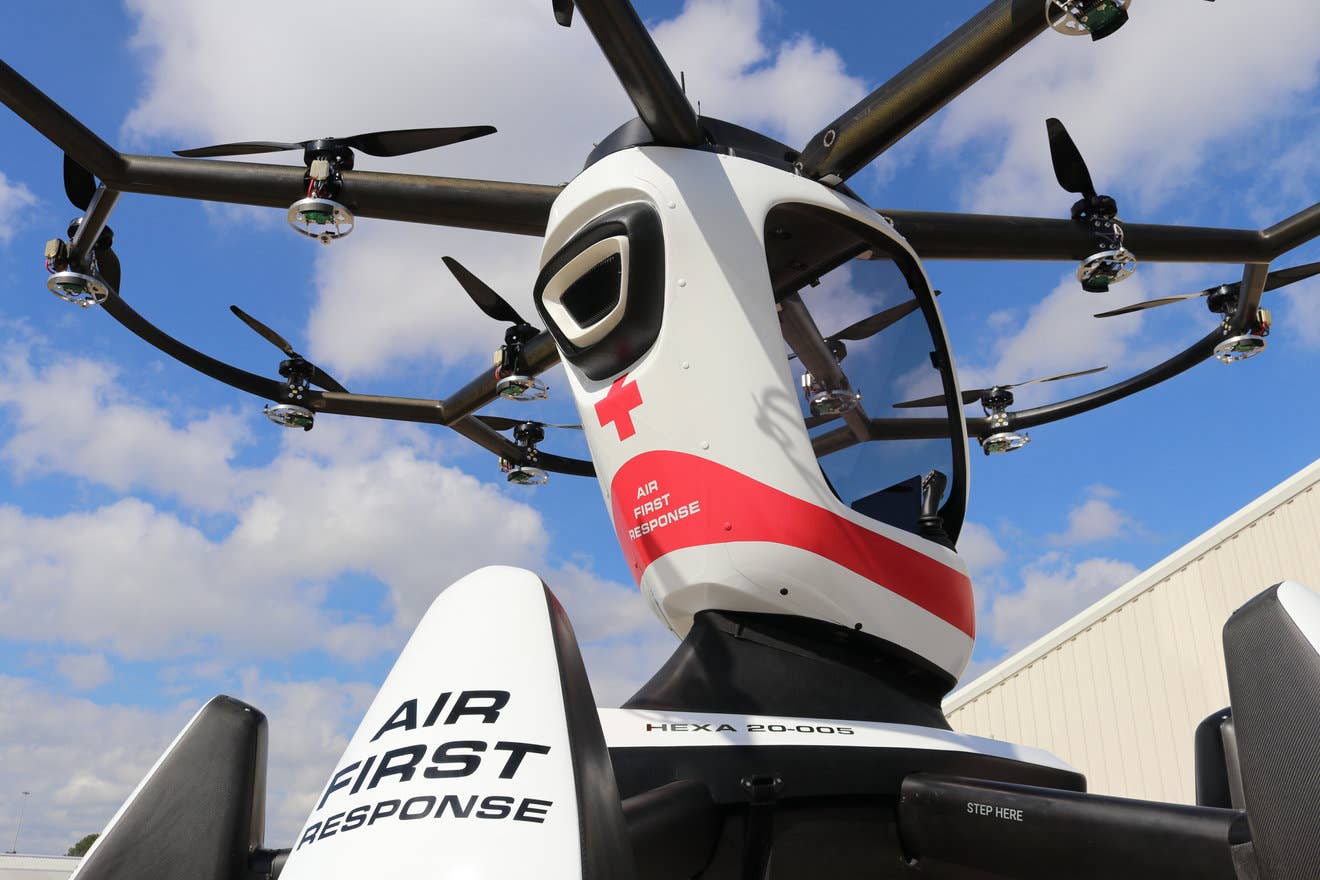Lift Aircraft Sells Outlandish, Ultralight Personal eVTOL to Public Safety Agencies
The manufacturer of Hexa is now selling the pinwheel-shaped aircraft to law enforcement, first responders, medical providers, and other customers.

Lift Aircraft’s Hexa may soon assist firefighters, police, emergency medical services, and other customers. [Courtesy: Lift Aircraft]
If you look to the skies next year and are shocked to see your local firefighters, police officers, or emergency responders zipping around in strange, futuristic aircraft…don’t say we didn’t warn you.
Lift Aircraft, the manufacturer of a funky, single-seat electric vertical takeoff and landing (eVTOL) design called Hexa, on Thursday announced that the aircraft is now on sale to fire departments, police departments, medical providers, and other public safety agencies.
Hexa has been in development for six years, and it’s finally ready to hit the market. The eVTOL was designed for “anyone” to get flying in a fraction of the time it would take to obtain a pilot’s certificate. But while the aircraft will eventually be marketed for personal use, law enforcement agencies and first responders will get the first crack at it.
Only five aircraft are being allocated to public agency partners, who can opt in with a refundable deposit before year’s end to reserve their delivery. Buyers can also take a trip out to Lift’s training facility near Austin, Texas, where a team will teach new pilots the ropes and talk through optimal use cases.
Lift customers will be able to fly Hexa for firefighting, police, medical, search and rescue, emergency, and disaster response applications under FAA public aircraft operations rules. And since it qualifies as a Part 103 ultralight, no pilot certification is needed to operate it. Beginner training on the aircraft’s control system—which consists of a single, three-axis joystick—can wrap up in less than an hour, the company claims.
Journalist Anderson Cooper and others with zero or minimal flight experience have already taken Hexa to the skies. FLYING got the chance to try out a simulator at UP.Summit in Dallas in October—the experience was akin to a virtual reality video game.
The Specs
Hexa’s pinwheel-shaped design uses distributed electric propulsion from 18 independent 126-kilowatt electric motors and propellers, each with its own battery pack. A redundant autopilot computer and the joystick control flight, but users can also switch to what Lift playfully calls “Look, mom, no hands!” mode. The aircraft can fly and land safely—even on water—with up to six motors disabled. Its airframe is built entirely of carbon fiber.
Weighing just 432 pounds, Hexa qualifies for the FAA’s powered ultralight classification, allowing it to be flown without a license. The eVTOL’s ultralight qualification was confirmed by the Light Aircraft Manufacturers Association (LAMA) in 2022.
The 15-by-15-foot aircraft folds down to about 9.5 by 7.5 feet, but it can carry up to 250 pounds (or up to 350 pounds in cargo configuration). Endurance (10 to 17 minutes) and range (8 to 15 sm) depend on payload. It cruises at around 60 knots at up to 9,000 MSL and can even fly in 20-knot winds, medium rain, and temperatures between 0 and 120 degrees Fahrenheit.
Versatility is the key here: Lift says Hexa’s unique features can benefit a plethora of different customers. Firefighters could douse blazes in hard to reach places. Disaster response teams could drop or extract personnel or supplies in places where helicopters can’t land. Emergency medical services could deploy air ambulances that arrive 80 percent faster. Even the U.S. Coast Guard could find some value, bringing Hexa in for a water landing to make an offshore rescue.
For those public safety agencies wary of deploying such a strange, unfamiliar aircraft, it may be reassuring to hear that Lift has already completed a pre-operational flight and safety test program.
Oh, and it’s also been researched, developed, and tested over the course of five contracts with AFWERX, the innovation arm of the U.S. Air Force. That relationship began with an initial agreement in 2020 and blossomed into a Phase 3 contract, which has allowed Lift to train Air Force pilots on Hexa’s simple controls. Last year, airmen made their first remote flight at Eglin Air Force Base’s Duke Field (KEGI) in Florida.
But Air Force pilots and public agencies won’t be the only Hexa customers, Lift says. Eventually, the company claims, people will be able to walk into a Lift vertiport, train for less than an hour, and leave in an eVTOL flying solo—even in places like New York City.
Last year, Lift signed a tentative agreement with the Big Apple’s Charm Aviation, one of the East Coast’s largest helicopter tour operators, to bring Hexa to downtown Manhattan. FAA rules limit flights to uncongested flyover areas and uncontrolled airspace. But the company plans to dot the city’s waterfront with vertiports, providing access to a Class G VFR corridor that extends up to 1,300 feet.
Lift also intends to partner with the Warren Buffett-backed Marubeni Corporation to commercialize Hexa in Japan. The aircraft has already made public demonstrations in the country, and Marubeni could preorder as many as 100 of them.
Like this story? We think you'll also like the Future of FLYING newsletter sent every Thursday afternoon. Sign up now.

Sign-up for newsletters & special offers!
Get the latest FLYING stories & special offers delivered directly to your inbox






